All-Star Squadron #9 Creative Team:
Creative Team: Roy Thomas-writer, Adrian Gonzales-pencils, Jerry ordway-art, John Costanza-letters, Carl Gafford-colors, Len Wein-editor.
Steel flashback from Steel #6 (unpublished), with Gerry Conway-writer, Don Heck-pencils.
Synopsis: Steel is in the White House, ringing in the new year, along with FDR, WC and the ASS....er..All-Stars. He's just been promoted to Commander Steel, even though he isn't in the Navy.

The gang present toasts and banter and Sir Justin sucks up to Churchill, while Hawkgirl confides in Firebrand that she can't wait to hear from Carter Hall. Atom has to be getting back to training; but, wants to hear the rest of Commander Steel's story. He dusts of Cancelled Comic Cavalcade #2 and gets on with it.
Steel and two commandos (who parachuted without helmets, jump smocks or other standard airborne gear) have landed in Poland and head for a rendezvous with the resistance. They see a passing motor convoy and take a look at their map, when they are surprised by the Germans. They open fire, despite being massively outgunned, with a squad of MP-40s and Kar 98's against 3 Sten guns.
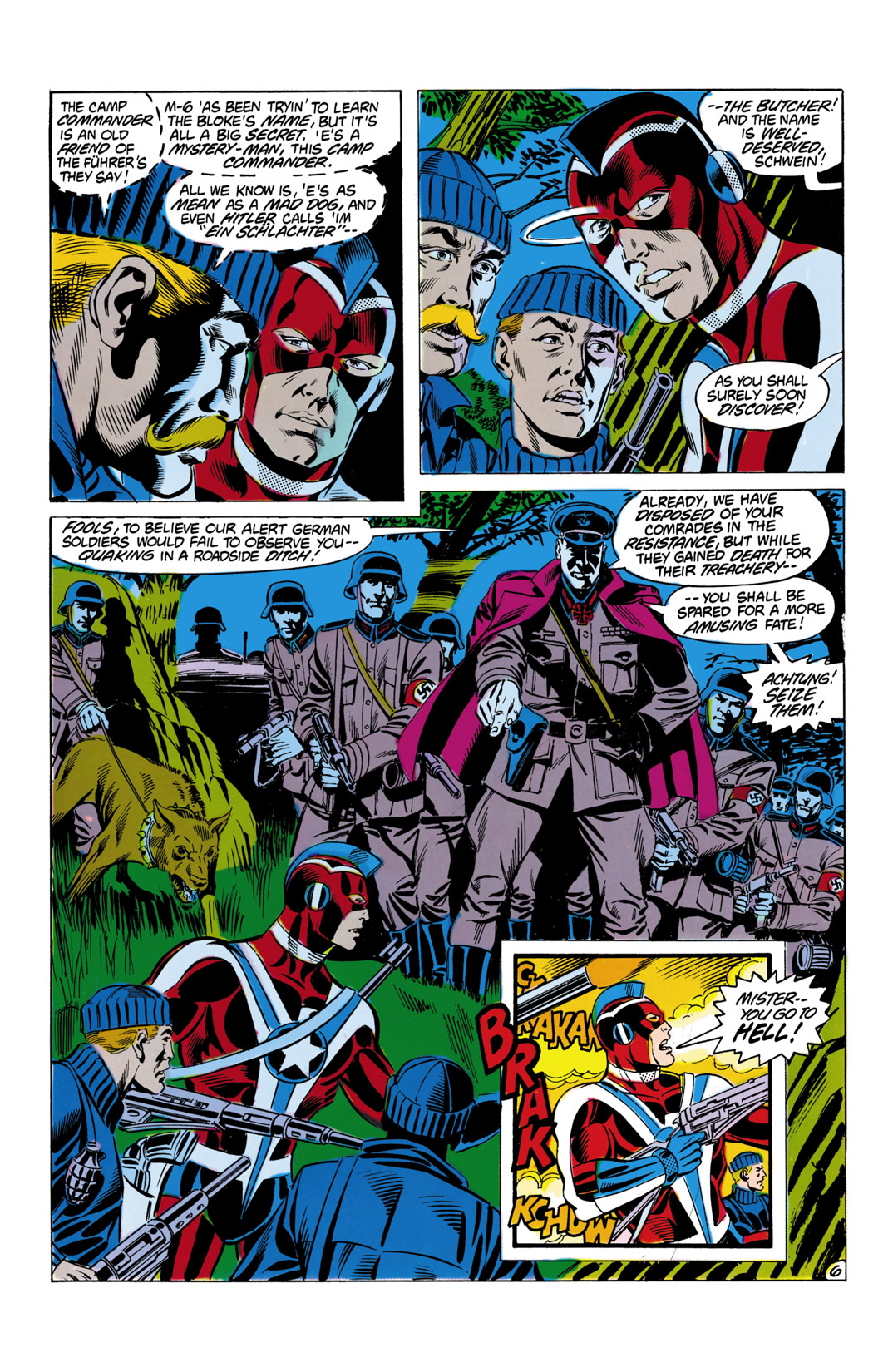
Steel fights off goosesteppers and their hunds, but gets a rifle cracked across the back of his skull and goes down. he wakes up inside a concentration camp...
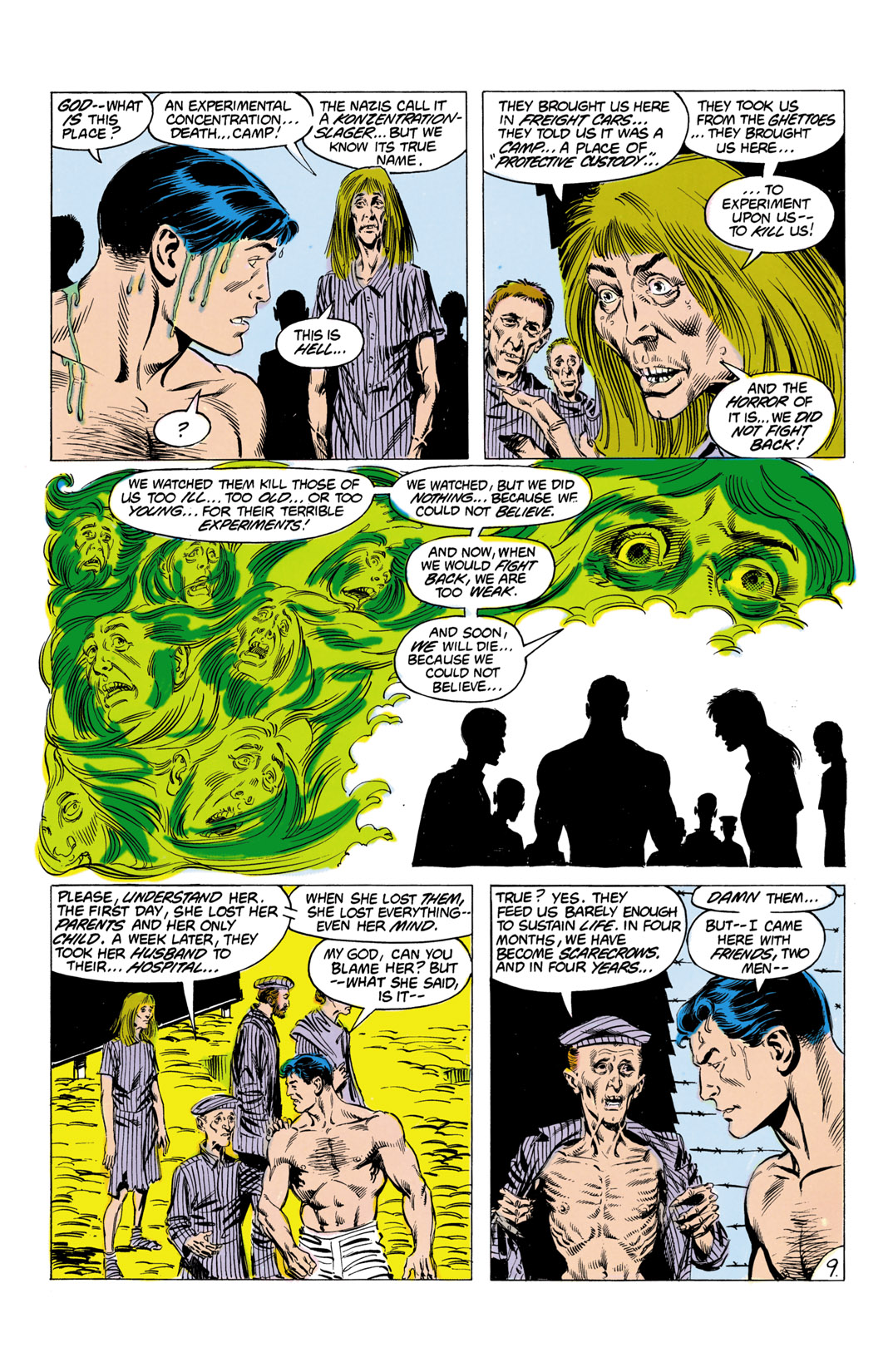
He's told his two SOE compatriots have been taken to the hospital area and he goes bezerk and leaps onto the fence and tears through the barbed wire. he tears through the goons, while clad only in his skivvies, stealing an MP-40 and mowing down Heinies, until he is hit with a staff car!. He wakes up in the hospital, manacled to a table. The Ratzis know about his enhancements, thanks to X-rays and the head goon wants an army of men like him (sounds familiar...). Well, faster than you can say Captain America's chain mail is rusty, Steel breaks free of the table and dives out a window, after snatching up some acid. A bullet creases his forehead and down he goes (despite the steel skull). One of the camp inmates picks up the bottle of acid and hurls it at the Kommandant, scarring his face (that sounds familiar, too). Then, Hitler shows up.
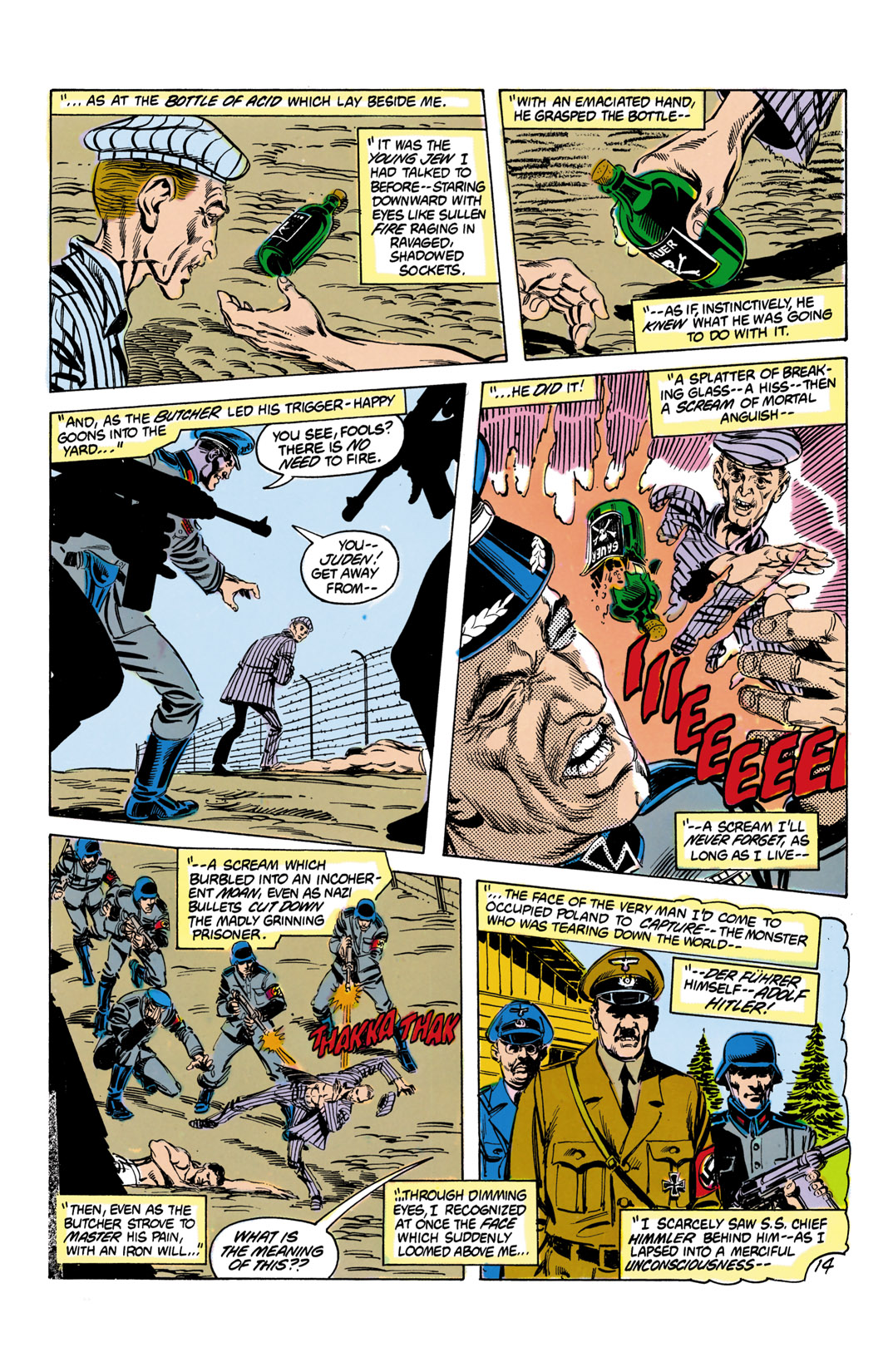
Steel passes out among a hail of "Sieg heil!" and "Heil me!" he doesn't remember anything else and no one finds this fishy. The team seems to swallow it.
meanwhile, Baron Blitzkrieg and Zwerg listen in. He relates the part that Steel has forgotten. He came to, lept up and attacked Hitler, but was clubbed down by bodyguards. The Kommandant was scarred, but given experimental injections which boosted his brain power and his speed and strength and gave him the ability to fly. he becomes Baron Blitzkrieg, suggesting he also lost his color sight.
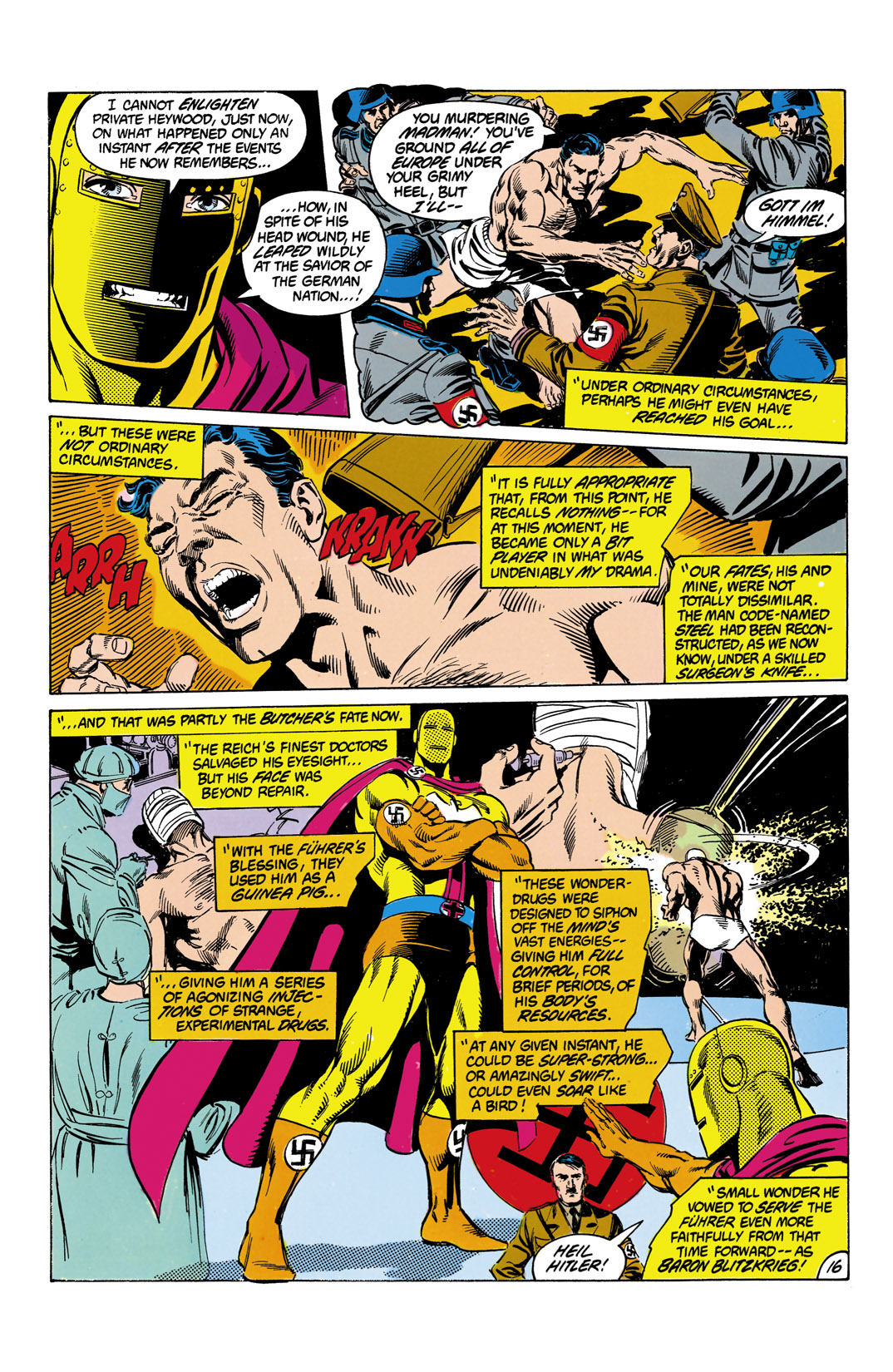
Steel was brainwashed and turned into a Manchurian Candidate, minus Angela Lansbury, for a mother.
Hawkgirl gets her phone call from Hawkman, but the line is interrupted, for Steel, who answers, then goes bezerk. Libby smells a rat and orders Johnny to get FDR and WC out of harms way. Robotman goes on the attack, while Firebrand encircles the two leaders in a ring of fire. Robotman and Commander Steel slug it out...
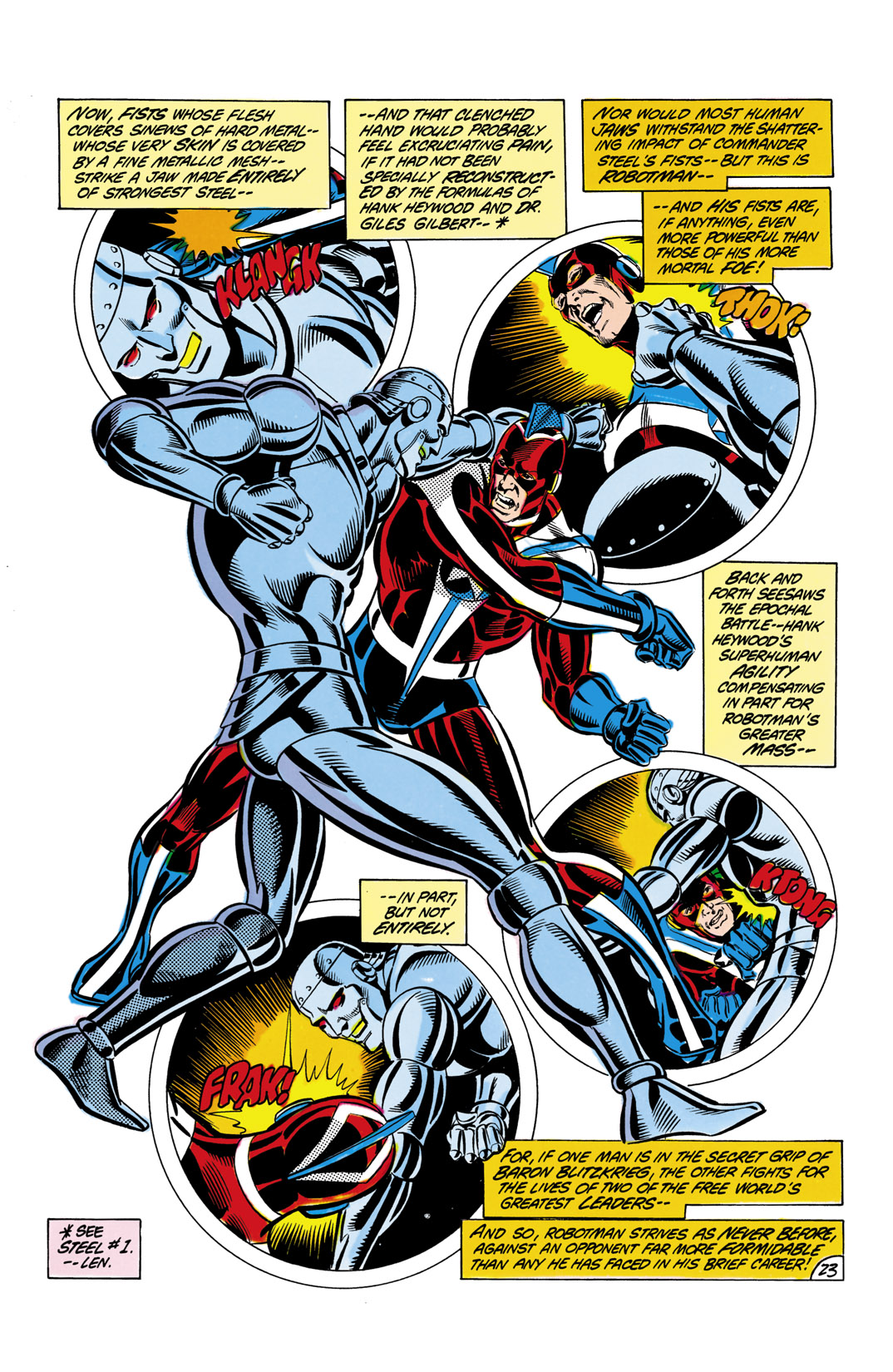
(Steel is getting close to hitting below the belt!)
Steel gets stronger and we learn that BB is somehow transmitting power from himself to Steel. Firebrand hits him in the face with a fireball, which breaks BB's hold on him and wakes him up...
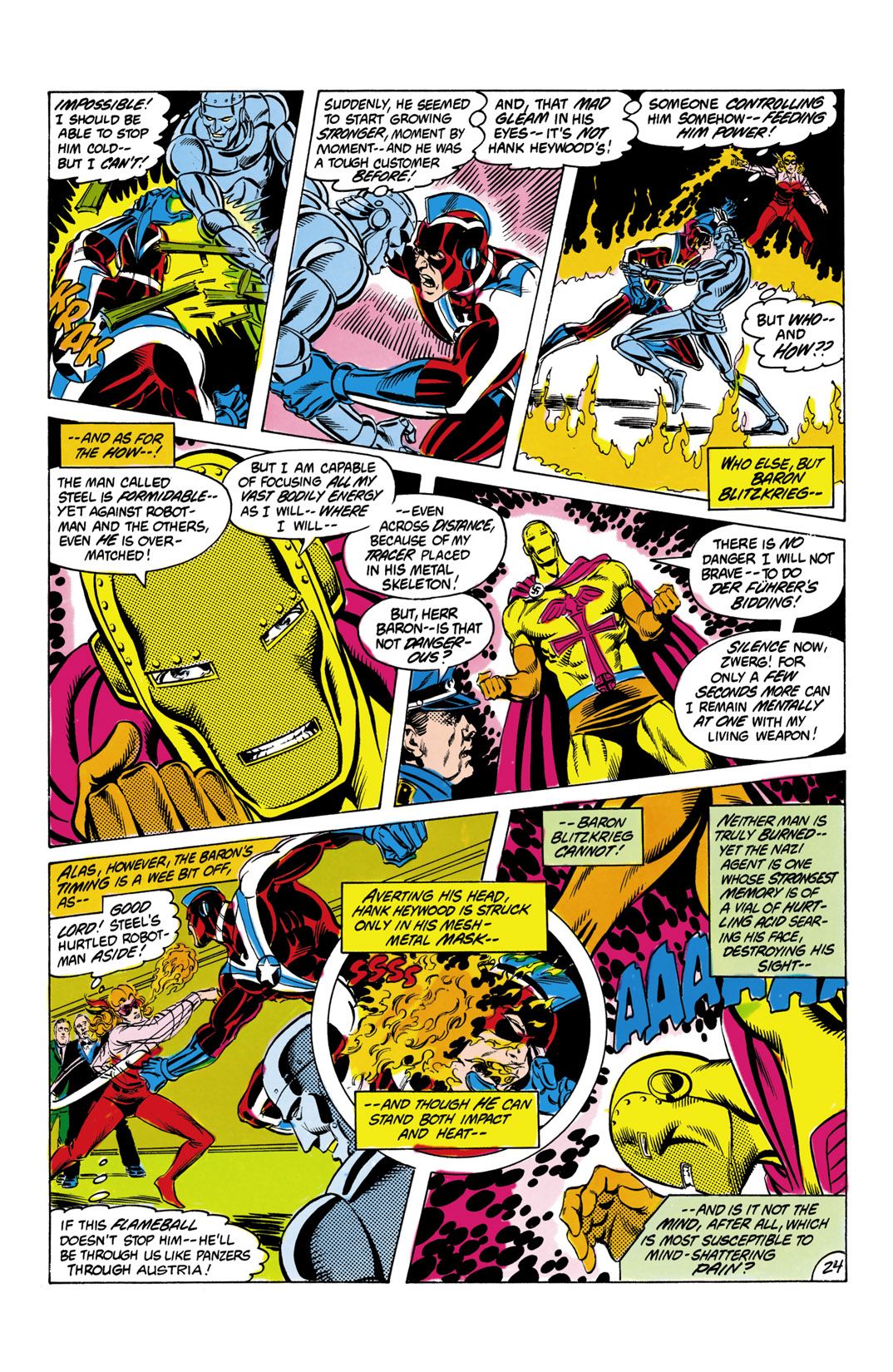
BBis blind and helpless and Cdr Steel is free. The All-Stars celebrate and the Baron whimpers
Thoughts: one of my favorite issues in the series. Roy does a great job combining the Steel story with this series, to create an attack on FDR and WC. The Captain America swipes are most prominent in the Conway plot, though the brainwashing premise matches a Lee & Kirby Cap story, from Tales of Suspense, as well as the Manchurian Candidate.
Again, Ordway holds the two segments together, to help nudge Heck and Gonzales together.. The fight is exciting and the conclusion works pretty well, though you would have to think they would want to examine Steel some more and test his mental conditioning.
This wraps up another great sequence, as this series was on fire, during its first year. The stories are brisk, the villains dastardly, and Roy slips in various character moments. I think they are rushing things a bit on how emaciated the camp victims are; but, it's not the first manipulation of time for dramatic effect.
Historical Notes: The Nazis first built concentration camps soon after coming to power in germany, using them to detain political opponents and "undesirables. This was extended as the Germans stretched their military might through conquest. The first Polish camps appeared in 1939, with the most infamous, Auschwitz constructed in 1940. So, maybe the emaciation isn't too abrupt, after all. There were different types of camps, from the earliest detention camps, to State Camps (run by the SA, which were the models for those run by the SS, after the SA was broken up), Hostage Camps (where hostages were taken after acts of resistance, usually temporarily, before execution, in reprisal), Labor Camps, POW Camps, Reeducation Camps (used for ethnic Poles, for re-education to Nazi propaganda), Collection and Transit Camps and Extermination Camps. Some fulfilled multiple functions. Many were used for medical experiments, as we see, such as those conducted by Dr Josef Mengele, at Auschwitz and Gross-Rosen. His most notorious experiments involved twins, injecting one with typhus, amputating limbs and other horrors, to study the affect on the victim and any perceived physical effect on their twin. Prisoners were kept on starvation diets and the way to survive was to steal food and make oneself useful to the Nazis, either as tradesmen or some similar function. Camps were policed by Kapos, who were inmates who were given better treatment, in return for maintaining order in the camps, similar to a prison trustee, though with far more sinister results. The SS administered the camps, often with the aid of locals who acted as guards and functionaries, particularly in places like Poland and the Ukraine.
The prisoners of these camps ranged from political dissidents (social democrats, communists, resistance leaders), Jehovah's Witnesses, the Romani, Poles, Slavs, homosexuals, Serbs, clergy, disabled or "deviant", and, most notably, Jews. Russian POWS were subjected to harsher treatment than Western Europeans, often in the same conditions as the labor and extermination camps. In fact, the escape from Sobibor was in large accomplished due to the presence of a large number of Soviet soldiers in the camp.
Figures vary but the YS Holocaust Memorial Museum estimates that some 15 to 20 million people were imprisoned or murdered in the camps and ghettos, under the Nazis. Estimates of the death toll include 6 million Jews and 11 million others (especially the Romani and Slavs).
Sadly, such camps were not unique to the Nazis. The Spanish used similar camps in Cuba, the US in the Philippines, and the British in South Africa, not to mention such things as the reservation system, which shared many similarities of relocating people to restricted areas. The Nisei and some Italian and German Americans wee placed in internment camps in the US and Canada (as well as Japanese immigrants and descendents in Latin America). While those facilities were used for detention and not outright murder, conditions in such camps were often dangerous to the physical health of inmates and greatly affected their mental health. Nisei children played baseball under the eyes of armed watchtowers and within barbed wire enclosures. Neither side had totally clean hands in the matter of detention of innocents.
Don Heck depicts the two commandos as wearing black pants, sweaters and watch caps (colored dark blue). This matches a typical Hollywood depiction of such things; but, not the reality of such missions. Most likely, these men would be part of the Special Operations Executive. The SOE conducted intelligence gathering and sabotage in the occupied territories, coordinating resistance efforts and relaying messages. Many foreign nationals were trained by the SOE for deep cover missions in their homelands. Usually, they operated in teams of two or three, with one acting as a radio operator, while the other coordinated resistance activities and engaged in intelligence gathering. There was also a commando unit made up of foreign nations, the X Commando. The SOE was formed under Churchill, as part of his strategy to "set Europe ablaze." Agents came from all walks of life, men and women, even known homosexuals, criminals, a military discipline cases.
Weapons and equipment varied, though agents generally used radio sets that fit into suitcases, carried knives, sabotage devices and explosives, sidearms, and specialized weapons, such as the noise suppressed De Lisle Carbine.

The weapon was based on a hunting rifle, cut down and fitted to fire .45 ACP rounds, though a noise suppressor. The Suppressor was contained within the rifle and featured a series of chambers and baffles to redirect the explosive gases released when the primer was ignited, much like a car muffler redirects the exhaust of an internal combustion engine, reducing the noise level. It was bolt action, so there was no noise from a receiver opening and closing to eject a spent cartridge,as with an automatic weapon.
A favorite weapon for the SOE and to arm resistance units was the Sten Gun...

Seen here is the Mark II, with skeletal stock, which is what Don Heck drew. This model also had a singular tubular stock, with a metal shoulder plate. The Mark VI version, used by the Paras, had a foregrip mounted under the barrel and there was a version with a noise suppressor that was very effective. The weapon was cruder than the heavier Thompson M1 submachine gun and less well manufactured than the German MP-40; but, it was robust and effective at close range. It's compact size made it concealable and it could easily be broken down into three components: the stock, the main receiver, and the barrel. A pin was pushed in at the rear of the main receiver to release the stock and the barrel could be unscrewed. The magazine well could be rotated by pulling a spring-loaded clamp and swiveling it, to cover the ejection port. The magazines were known to be a bit of a weakness and care had to be taken with them to prevent feed jambs. The weapon was not a favorite of the military, who preferred the more robust Thompson; but, it was cheap and easy to manufacture and easy to use, which made it ideal for resistance units. some 3-4 million were manufactured and it remained in service until the early 1953, when it was replaced by the Sterling.
Hollywood tends to show soldiers holding the magazine in their left hand as they fire the weapon; but, this was not the standard method. trained soldiers usually fired it by gripping the underside of barrel or receiver, while resting the magazine against their forearm.
X Commando (or No. 10 Commando) was the Inter-Allied Commando formation, made up of Allied soldiers from occupied territories, including France, Belgium, the Netherlands, Poland, Norway, Denmark and Yugoslavia. itw as organized into troops, with nationalities being kept together. In many ways, this (and the Polish fliers of the RAF) are the basis for the Blackhawks (as well as the Flying Tigers, in China). By war's end, they were the largest Commando formation, though they generally worked in smaller units, attached to larger forces. Norwegian members aided in raids on the Norwegian coast, while Yugoslav commandos worked with the Partisans. The French commandos conducted reconnaissance raids, prior to the D-Day landings and were instrumental in the 1st Special Service Brigade's capture of Ouistreham.
Commandos carried a variety of weapons, but were outfitted in military kit, usually with two ammo pouches for either Thompsons or Stens, a segment of toggle rope, a commando knife, grenades, and other more specialized equipment. Commandos often wore combat sweaters and balaclavas, to protect against the cold along the seashore. Hollywood often substituted knit watch caps for the balaclavas and black turtlenecks for the standard commando wool sweater. Commandos did use burnt cork to blacken their faces, during night raids, to reduce reflectivity of their skin. Quite often, they wore the general issue steel "Tommy" helmets and carried the Enfield rifle, as well as the Thompson and Sten.
Typical commando uniform, kit and weapons...

Hollywood and comics love to use the german MP-40, known (incorrectly) as the Schmeisser...

The weapon appeared as the MP-38 and MP-40, with a slight variation between models. They were often used by tank crews, NCOs, fallschirmjager (paratroops) and other special troops. The standard infantry weapon was the Kar 98

...but, infantry were often armed with MP-40s, beyond squad and platoon leaders. On the Eastern front, assault units would be issued MP-40s, as they faced whole squads armed with the Ppsh-41 submachine gun, giving the Soviets a numerical advantage in rounds fired, vs the bolt action Kar 98s. Later, the Germans developed the STG-44, or sturmgewehr (assault rifle)
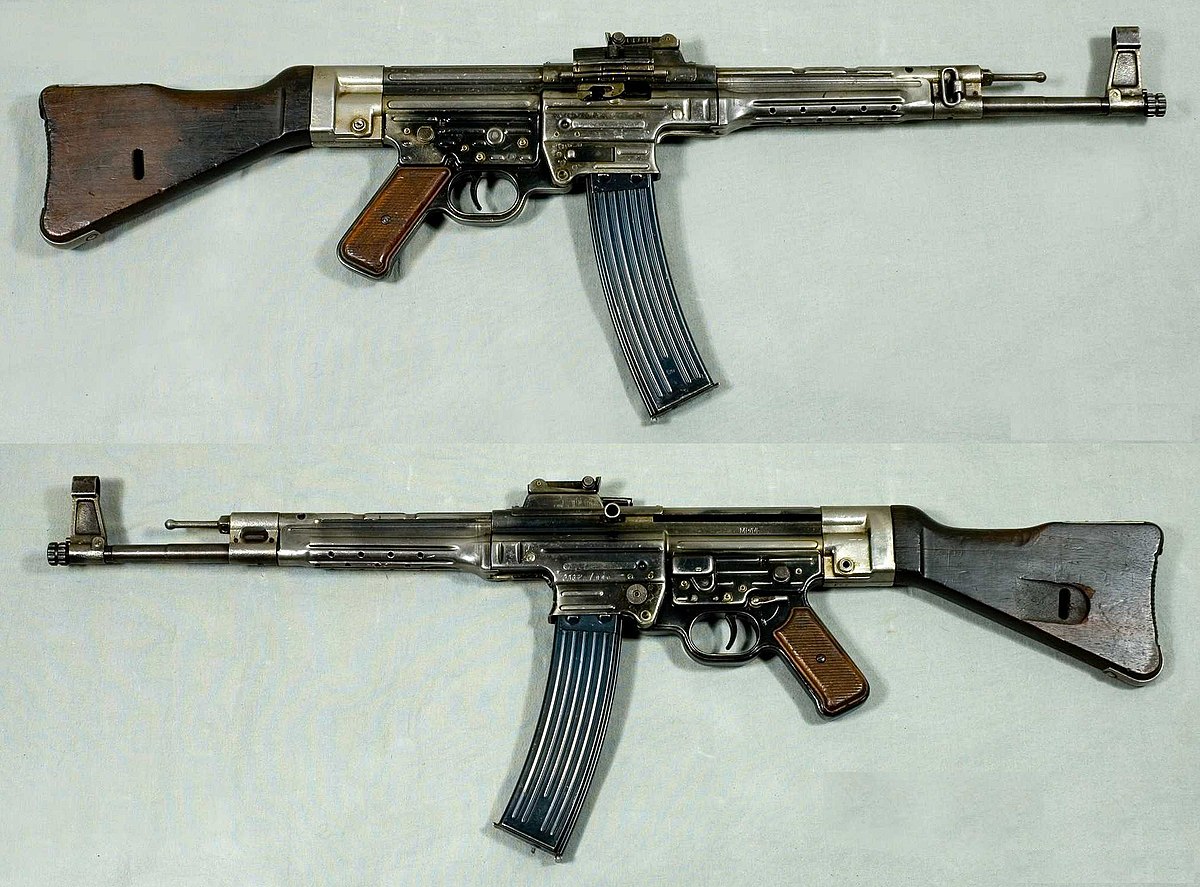
Fallschirmjagger also carried the FG42, a compact and lighter weight light machine gun...
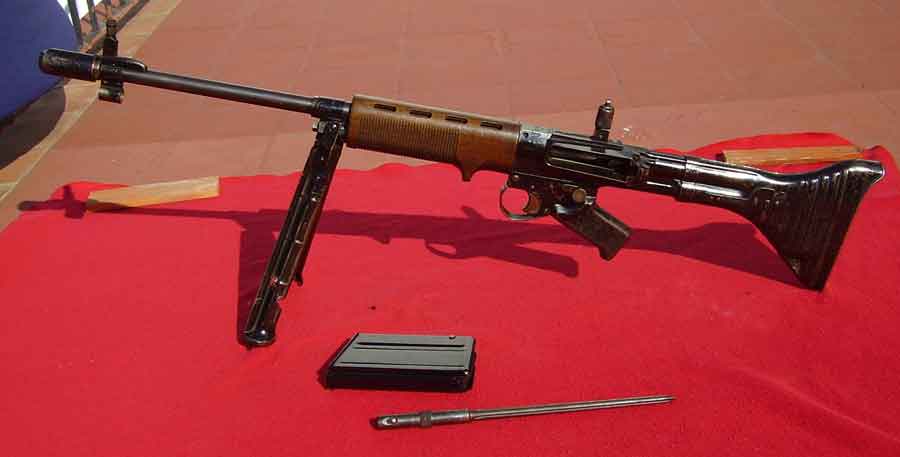
rather than the bulkier MG-34 and MG-42...

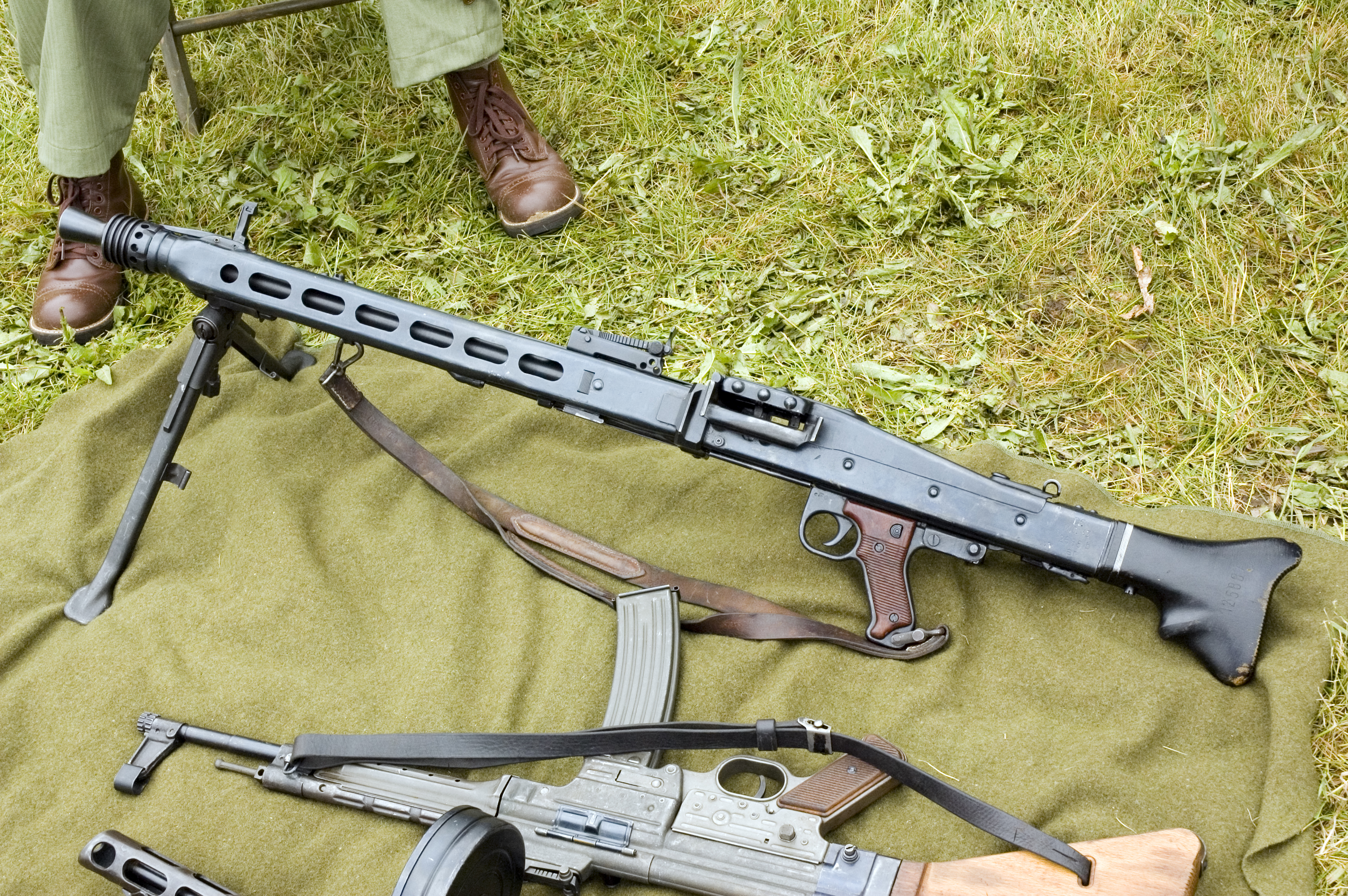
The light machine guns were seen in war movies and war comics, depending on the artist. Few ever depicted the more specialized fallschirmjager weapons, though Jack Kirby included some in his Losers stories, and in reference pin-up pages. The MG-34 was used for the larger stormtrooper rifle, seen in the original Star Wars, in scenes where they attack the Millennium Falcon in its hanger, on Tatooine, and on the Death Star, when Han and Luke escort Chewbacca to the detention center. The STG-44 can be seen in the spy movie Funeral in Berlin and also The Spy Who Came in From the Cold, as the AK-47 was not in many Western hands, at that point.
The Manchurian Candidate was written by Richard Condon and featured an American soldier, captured in Korea, who is brainwashed in Manchuria to assassinate the presidential candidate, so that the vice-presidential candidate can be installed in the White House and controlled via a covert agent. It was adapted into the famous film, directed by John Frankenheimer and starring Frank Sinatra, Laurence Harvey and Angella Lansbury and later remade in 2004 by Jonathan Demme, with Denzel Washington, Liev Schreiber and Meryl Streep. Both films are quite good; but, the original is a cinema classic. The assassin, Raymond Shaw, is the son of Eleanor, and his step father (played by James Gregory) is the VP candidate, a rather McCarthy-esque type. Part of the programming involves code words over the phone and the use of the Queen of Hearts, from a deck of playing card, to trigger post-hypnotic suggestion. Sinatra is a soldier who was captured with Shaw, who never liked him; but, when asked, is compelled to praise him as a hero. he is plagued by nightmares of his brainwashing and seeks the answer. The 2004 version changed it from the Cold War to modern defense contractors and intelligence groups. Both are rather chilling in the plausibility of the idea.
Here, Commander Steel is captured and subjected to brainwashing to be turned into an infiltration and assassination weapon, to get to FDR and Churchill, thereby crippling the Allies with the loss of strong, charismatic leaders. his original mission was the capture Hitler, to accomplish a similar feat, with the Nazis. It is questionable if the loss of Hitler would have destroyed the German war machine. It would lead to infighting in the Nazi power circles; but, the Wehrmacht would be rid of Hitler's hands-on planning and would have been less likely to commit to a war on multiple fronts. They also would have likely responded to the Allied invasion threats with different tactics, including the deployment of armored units at the start of the D-Day landings, not to mention earlier withdrawal of the Afrika Korps. The top candidates for assuming authority would have been Goering and Himmler, though Hess and Goebbels would be major players. A lot would depend on who the Wehrmacht would support, even more than the Luftwaffe or Kriegsmarine.